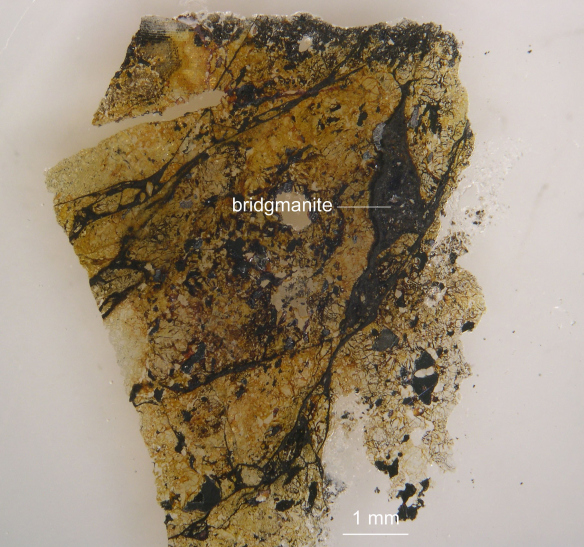What’s in a name? – Bridgmanite

Figure 1: Crystal structure of the distorted perovskite MgSiO3. Image generated in VESTA.
Something very significant happened last month; a mineral known to exist for a very long time was finally acknowledged and given a name. That was silicate perovskite, the most commonly occurring mineral on the planet. Silicate perovskite, now known as bridgmanite, takes on a few elemental forms as it can, for example, incorporate magnesium, iron or calcium on the perovskite A-site. Of these the magnesium containing silicate perovskite, MgSiO3, is considered to be the most abundant mineral on the planet. Despite this abundance, naturally occurring silicate perovskites had never been directly observed as it can only be found in the lower mantle, as inferred from high temperature sound velocity data.[1, 2] The only way the structure was able to be studied was from silicate perovskite created synthetically using laser-heated diamond anvil cells, which recreate the conditions present in the lower mantle.[3, 4] However, since a naturally occurring form had never been directly observed or studied the mineral was never formally recognised with its own name.

Figure 2: A fragment of the 4.5 billion year old Tenham meteorite containing shock veins of bridgmanite. Chi Ma via the American Geophysical Union <http://blogs.agu.org/geospace/files/2014/06/bridgmanite_label.jpg>, Accessed 7/7/14
So what is in a name? What was required for the most common mineral on earth to finally be recognised as a mineral and given a name? For the Commission on New Minerals, Nomenclature and Classification (CNMNC) of the International Mineralogical Association (IMA), the composition and structure of a naturally occurring sample must be known. Ironically, the final composition and structure of the most common mineral on earth was finally determined from a meteorite. That is, a 4.5 billion year old meteorite which landed 135 years ago in our very own backyard, near the Tenham Station in western Queensland.
The bridgmanite was formed inside the meteor following collisions with other asteroids in space. The high pressures and temperatures experienced in these collisions generated "shock veins" of the mineral through the meteor (Figure 2). The presence of silicate perovskite in these veins was determined following five years of work by Dr Chi Ma from California Institute of Technology and Prof Oliver Tschauner from the University of Nevada-Las Vegas.[5] The mineral was identified using synchrotron X-ray diffraction mapping and the compositions were confirmed using a high resolution scanning electron microscope.
The mineral was named after the physicist Percy Bridgman who won a Nobel Prize for high pressure physics. This name pays homage to the large body of high pressure research which has been performed on synthesising and understanding silicate perovskites.
[1] M. Murakami, S.V. Sinogeikin, H. Hellwig, J.D. Bass, J. Li, Earth and Planetary Science Letters, 256 (2007) 47-54.
[2] M. Murakami, Y. Ohishi, N. Hirao, K. Hirose, Nature (London, UK), 485 (2012) 90-94.
[3] L.-G. Liu, Geophys. Res. Lett. 1 (1974) 277-280.
[4] L.-G. Liu, Geophys. Res. Lett. 2 (1975) 417-419.
[5] J. Wendel, Eos, Transactions American Geophysical Union, 95 (2014) 195-195.






